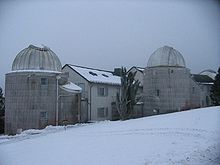Hoher List Observatory
The Hoher List observatory is an observatory about 60 km south-southwest of Bonn near the town of Daun on the Hoher List mountain ( 549 m above sea level ) in the Eifel ( Rhineland-Palatinate ).
history
After astronomical observations in Bonn were mainly carried out by the old Bonn observatory until after the Second World War , the increasing spread of electric light in the cityscape (lanterns and room lighting) made observations more and more difficult, as the night sky of the city continued to brighten.
In search of an alternative to the Bonn location, around 1950 the summit of the Hoher List mountain above the village of Schalkenmehren was found to be a good astronomical observation site. In this rural setting, the sky was hardly brightened. It was decided to build a new observatory there and to move the telescopes from Bonn there.
In 1954 the new “Hoher List Observatory” was inaugurated with the first dome, which contained a Schmidt telescope with a mirror diameter of 50 cm. In 1964 it was significantly expanded and then the double refractor built in 1899 was relocated from Bonn to the Eifel. The last dome to be erected at the observatory contains a 1 m Cassegrain telescope , its largest and most modern telescope.
Today there are six different telescopes on the observatory grounds. In addition to the double refractor, which is over 100 years old, there is also the telescope with which the southern part of the Bonn sky survey of Córdoba (Argentina) was carried out. It is the "Schröder refractor", a lens telescope with a 16 cm opening.
Since its inception, the observatory has been a branch of the Bonn observatory (later: Observatory Department of the Argelander Institute for Astronomy at the University of Bonn ), where many students obtained their diplomas or doctorates and many important scientific works in the field of astrometry (Location and movement) and photometry (brightness and color) of stars in our Milky Way .
In the course of time, the “Hoher List Observatory” lost its former scientific importance, as observing in the Eifel became more difficult. On the one hand, the brightness of the sky had also increased significantly there and the weather conditions were not comparable with the excellent observation locations in Chile or the USA . Therefore, the observatory took over the practical part of the student training and served as a laboratory environment for new astronomical instruments or components that were then attached to telescopes, e.g. B. were used in Spain or Chile. From 2007, however, the 1 m telescope of the observatory was used again for current research in the field of the gravitational lens effect through the HOLIGRAIL project (HOher LIst GRAvItational Lensing) .
Closure and further use
The Argelander Institute for Astronomy completely stopped scientific training and observation operations in February 2012 and the University of Bonn closed the observatory in July 2012. The scientific equipment, including the telescopes, should then be sold. In September 2013, however, the entire system of the observatory was placed under monument protection by the State Monument Preservation of Rhineland-Palatinate, preventing dismantling. One month earlier, the former support association of the Hoher List observatory was renamed the Astronomical Association Vulkaneifel am Hohen List eV and has since tried to keep the observatory open to the public through regular guided tours, lectures and astronomical observation events.
In 2015 the artist group SternwARTe Vulkaneifel eV was founded in order to enable cultural re-use for the people of the region.
Web links
Individual evidence
- ↑ astro.uni-bonn.de: Argelander Institute for Astronomy
- ↑ astro.uni-bonn.de: Homepage of the HOLIGRAIL Project
- ^ University of Bonn: Newsletter 7/2012
- ↑ Informational directory of cultural monuments. (PDF; 1.4 MB) Vulkaneifel district. General Directorate for Cultural Heritage Rhineland-Palatinate, p. 30 , accessed on October 1, 2013 .
- ↑ Kunststernwarte - Künstlergruppe Kunststernwarte Vulkaneifel eV Accessed on April 28, 2017 .
Coordinates: 50 ° 10 ′ N , 6 ° 51 ′ E


